Submitted:
31 August 2023
Posted:
31 August 2023
You are already at the latest version
Abstract
Keywords:
1. Introduction
2. Geological settings of chosen sites
2.1. Extensional basins in continental domains: examples of the Upper Rhine Graben (France) and Death Valley (USA)
2.1.1. Upper Rhine Graben (URG)
2.1.2. Death Valley with a focus on the Noble Hills
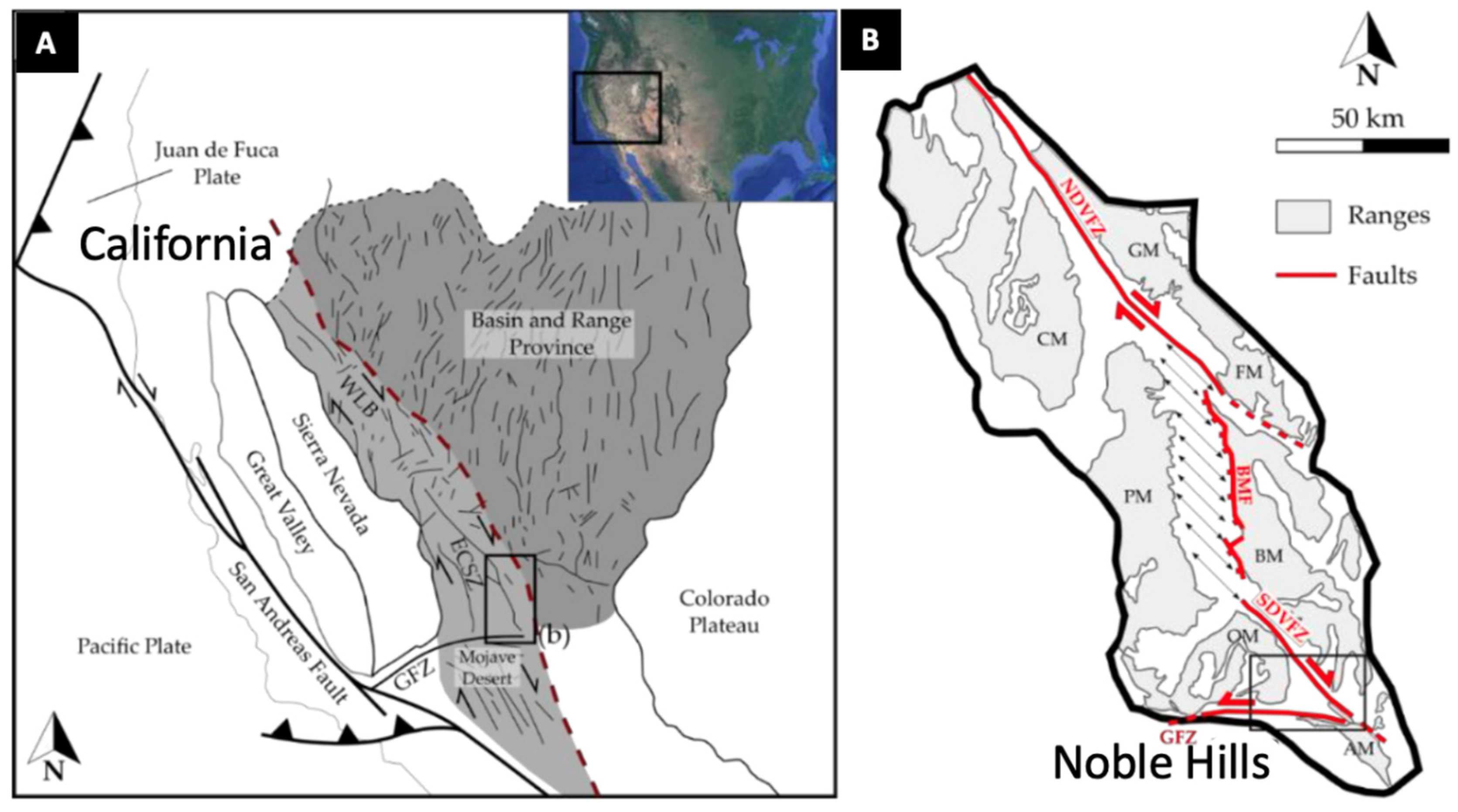
2.2. Volcanic islands: two examples in Guadeloupe archipelago (Bouillante geothermal power plant and its surface analogue in Terre de Haut, Les Saintes).
Guadeloupe archipelago
- 1.
- Bouillante
- 2.
- Les Saintes, Terre-de-Haut island
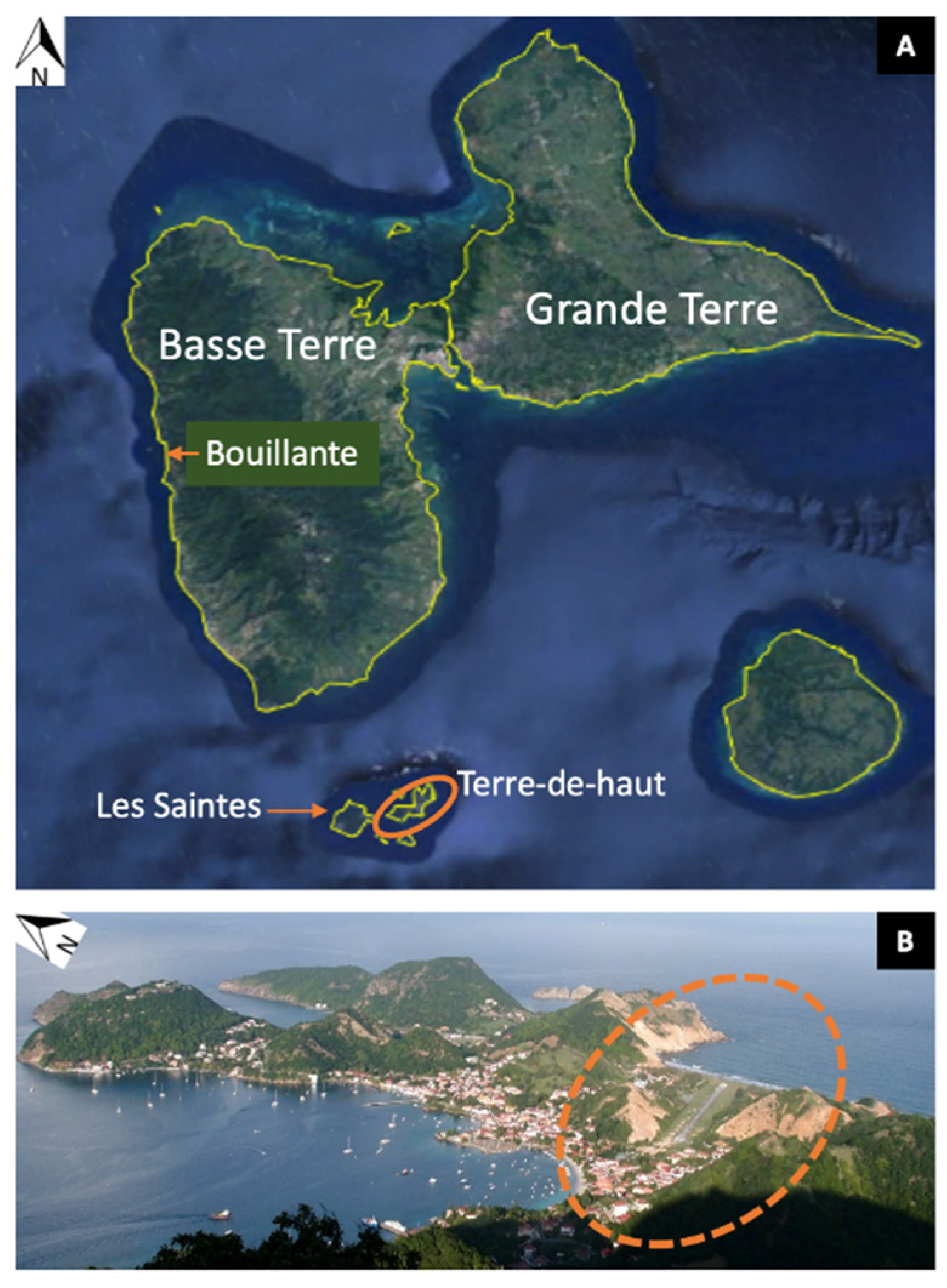
3. Clay minerals
3.1. Cap rock: Electrical resistivity, gravimetry and magnetotelluric exploration
3.2. Geothermal reservoirs
3.2.1. Types of hydrothermal alteration
- 1.
- Propylitic alteration
- 2.
- Argillic alteration
3.2.2. Tosudite, a specific lithium-rich clay mineral
3.2.3. Chlorite geothermometry
3.2.4. Use of illite (and muscovite).
- 1.
- Determination of temperature conditions using the Kübler Index
- 2.
- Dating of hydrothermal or metamorphic events
3.2.5. Deciphering meteoric and hydrothermal alteration based on clay minerals
4. Carbonates
5. Quartz
6. Discussion and conclusions
Funding
Data Availability Statement
Acknowledgments
Conflicts of Interest
References
- Navelot, V.; Géraud, Y.; Favier, A.; Diraison, M.; Corsini, M.; Lardeaux, J.-M.; Verati, C.; Mercier de Lépinay, J.; Legendre, L.; Beauchamps, G. Petrophysical Properties of Volcanic Rocks and Impacts of Hydrothermal Alteration in the Guadeloupe Archipelago (West Indies). Journal of Volcanology and Geothermal Research 2018, 360, 1–21. [CrossRef]
- Favier, A.; Lardeaux, J.-M.; Corsini, M.; Verati, C.; Navelot, V.; Géraud, Y.; Diraison, M.; Ventalon, S.; Voitus, E. Characterization of an Exhumed High-Temperature Hydrothermal System and Its Application for Deep Geothermal Exploration: An Example from Terre-de-Haut Island (Guadeloupe Archipelago, Lesser Antilles Volcanic Arc). Journal of Volcanology and Geothermal Research 2021, 418, 107256. [CrossRef]
- Verati, C.; Mazabraud, Y.; Lardeaux, J.-M.; Corsini, M.; Schneider, D.; Voitus, E.; Zami, F. Tectonic Evolution of Les Saintes Archipelago (Guadeloupe, French West Indies): Relation with the Lesser Antilles Arc System. Bulletin de la Société Géologique de France 2016, 187, 3–10. [CrossRef]
- Genter, A.; Traineau, H.; Dezayes, C.; Elsass, P.; Ledesert, B.; Meunier, A.; Villemin, T. Fracture Analysis and Reservoir Characterization of the Granitic Basement in HDR Soultz Project (France). Geothermal Science and Technology 1995, 4, 189.
- Hébert, R.L.; Ledésert, B.; Bartier, D.; Dezayes, C.; Genter, A.; Grall, C. The Enhanced Geothermal System of Soultz-Sous-Forêts: A Study of the Relationships between Fracture Zones and Calcite Content. Journal of Volcanology and Geothermal Research 2010, 196, 126–133. [CrossRef]
- Klee, J.; Chabani, A.; Ledésert, B.A.; Potel, S.; Hébert, R.L.; Trullenque, G. Fluid-Rock Interactions in a Paleo-Geothermal Reservoir (Noble Hills Granite, California, USA). Part 2: The Influence of Fracturing on Granite Alteration Processes and Fluid Circulation at Low to Moderate Regional Strain. Geosciences 2021, 11, 433. [CrossRef]
- Chabani, A.; Trullenque, G.; Ledésert, B.A.; Klee, J. Multiscale Characterization of Fracture Patterns: A Case Study of the Noble Hills Range (Death Valley, CA, USA), Application to Geothermal Reservoirs. Geosciences 2021, 11, 280. [CrossRef]
- Dezayes, C.; Villemin, T.; Pêcher, A. Microfracture Pattern Compared to Core-Scale Fractures in the Borehole of Soultz-Sous-Forêts Granite, Rhine Graben, France. Journal of Structural Geology 2000, 22, 723–733. [CrossRef]
- Ledésert, B.; Hebert, R.; Genter, A.; Bartier, D.; Clauer, N.; Grall, C. Fractures, Hydrothermal Alterations and Permeability in the Soultz Enhanced Geothermal System. Comptes Rendus Geoscience 2010, 342, 607–615. [CrossRef]
- Ledésert, B.; Dubois, J.; Genter, A.; Meunier, A. Fractal Analysis of Fractures Applied to Soultz-Sous-Forets Hot Dry Rock Geothermal Program. Journal of Volcanology and Geothermal Research 1993, 57, 1–17. [CrossRef]
- Vidal, J.; Genter, A. Overview of Naturally Permeable Fractured Reservoirs in the Central and Southern Upper Rhine Graben: Insights from Geothermal Wells. Geothermics 2018, 74, 57–73. [CrossRef]
- Sardini, P.; Ledésert, B.; Touchard, G. Quantification of Microscopic Porous Networks By Image Analysis and Measurements of Permeability in the Soultz-Sous-Forêts Granite (Alsace, France). In Fluid Flow and Transport in Rocks: Mechanisms and effects; Jamtveit, B., Yardley, B.W.D., Eds.; Springer Netherlands: Dordrecht, 1997; pp. 171–189 ISBN 978-94-009-1533-6. [CrossRef]
- Beauchamps, G.; Ledésert, B.; Hébert, R.; Navelot, V.; Favier, A. The Characterisation of an Exhumed High-Temperature Paleo-Geothermal System on Terre-de-Haut Island (the Les Saintes Archipelago, Guadeloupe) in Terms of Clay Minerals and Petrophysics. Geothermal Energy 2019, 7, 1–18. [CrossRef]
- Beauchamps, G.; Bourdelle, F.; Dubois, M.; Hebert, R.L.; Ledésert, B.A. First Characterization of the Cooling of the Paleo-Geothermal System of Terre-de-Haut (Les Saintes Archipelago, Guadeloupe): Application of Fluid Inclusion and Chlorite Thermometry. Journal of Volcanology and Geothermal Research 2021, 419, 107370. [CrossRef]
- Libbey, R.B.; Williams-Jones, A.E. Applications of Downhole Lithogeochemistry to Geothermal Exploration.
- Maffucci, R.; Corrado, S.; Aldega, L.; Bigi, S.; Chiodi, A.; Di Paolo, L.; Giordano, G.; Invernizzi, C. Cap Rock Efficiency of Geothermal Systems in Fold-and-Thrust Belts: Evidence from Paleo-Thermal and Structural Analyses in Rosario de La Frontera Geothermal Area (NW Argentina). Journal of Volcanology and Geothermal Research 2016, 328, 84–95. [CrossRef]
- Corrado, S.; Aldega, L.; Celano, A.S.; De Benedetti, A.A.; Giordano, G. Cap Rock Efficiency and Fluid Circulation of Natural Hydrothermal Systems by Means of XRD on Clay Minerals (Sutri, Northern Latium, Italy). Geothermics 2014, 50, 180–188. [CrossRef]
- Weaver, J.; Eggertsson, G.H.; Utley, J.E.; Wallace, P.A.; Lamur, A.; Kendrick, J.E.; Tuffen, H.; Markússon, S.H.; Lavallée, Y. Thermal Liability of Hyaloclastite in the Krafla Geothermal Reservoir, Iceland: The Impact of Phyllosilicates on Permeability and Rock Strength. Geofluids 2020, 2020, 1–20. [CrossRef]
- Lévy, L.; Gibert, B.; Sigmundsson, F.; Flóvenz, Ó.; Hersir, G.; Briole, P.; Pezard, P. The Role of Smectites in the Electrical Conductivity of Active Hydrothermal Systems: Electrical Properties of Core Samples from Krafla Volcano, Iceland. Geophysical Journal International 2018, 215, 1558–1582. [CrossRef]
- Lévy, L.; Maurya, P.K.; Byrdina, S.; Vandemeulebrouck, J.; Sigmundsson, F.; Árnason, K.; Ricci, T.; Deldicque, D.; Roger, M.; Gibert, B. Electrical Resistivity Tomography and Time-Domain Induced Polarization Field Investigations of Geothermal Areas at Krafla, Iceland: Comparison to Borehole and Laboratory Frequency-Domain Electrical Observations. Geophysical Journal International 2019, 218, 1469–1489. [CrossRef]
- Carapezza, M.L.; Ranaldi, M.; Gattuso, A.; Pagliuca, N.M.; Tarchini, L. The Sealing Capacity of the Cap Rock above the Torre Alfina Geothermal Reservoir (Central Italy) Revealed by Soil CO2 Flux Investigations. Journal of Volcanology and Geothermal Research 2015, 291, 25–34. [CrossRef]
- Dubois, M.; Ayt Ougougdal, M.; Meere, P.; Royer, J.-J.; Boiron, M.-C.; Cathelineau, M. Temperature of Paleo- to Modern Self-Sealing within a Continental Rift Basin: The Fluid Inclusion Data (Soultz-Sous-Forêts, Rhine Graben, France). ejm 1996, 8, 1065–1080. [CrossRef]
- Savary, V.; Dubois, M.; Ledésert, B.; Yardley, B.W.D.; Royer, J.-J. History of Fluid Circulation in an Alteration Zone of the Soultz-Sous-Forêts Granite (Alsace, France).; 1997; p. 292.
- Dubois, M.; Ledésert, B.; Potdevin, J.-L.; Vançon, S. Détermination Des Conditions de Précipitation Des Carbonates Dans Une Zone d’altération Du Granite de Soultz (Soubassement Du Fossé Rhénan, France): L’enregistrement Des Inclusions Fluides. Comptes Rendus de l’Académie des Sciences-Series IIA-Earth and Planetary Science 2000, 331, 303–309. [CrossRef]
- Ledesert, B.; Berger, G.; Meunier, A.; Genter, A.; Bouchet, A. Diagenetic-Type Reactions Related to Hydrothermal Alteration in the Soultz-Sous-Forets Granite, France. European Journal of Mineralogy 1999, 11, 731–741.
- Bottrell, S.H.; Yardley, B.W.D.; Buckley, F. A modified crush-leach method for the analysis of fluid inclusion electrolytes. bulmi 1988, 111, 279–290. [CrossRef]
- Banks, D.A.; Yardley, B.W.D. Crush-Leach Analysis of Fluid Inclusions in Small Natural and Synthetic Samples. Geochimica et Cosmochimica Acta 1992, 56, 245–248. [CrossRef]
- Hébert, R.; Ledésert, B.; Genter, A.; Bartier, D.; Dezayes, C. Mineral Precipitation in Geothermal Reservoir: The Study Case of Calcite in the Soultz-Sous-Forêts Enhanced Geothermal System.
- Favier, A.; Lardeaux, J.-M.; Corsini, M.; Verati, C.; Navelot, V.; Géraud, Y.; Diraison, M.; Ventalon, S.; Voitus, E. Characterization of an Exhumed High-Temperature Hydrothermal System and Its Application for Deep Geothermal Exploration: An Example from Terre-de-Haut Island (Guadeloupe Archipelago, Lesser Antilles Volcanic Arc). Journal of Volcanology and Geothermal Research 2021, 418, 107256. [CrossRef]
- A New Chlorite Geothermometer for Diagenetic to Low-Grade Metamorphic Conditions | SpringerLink Available online: https://link.springer.com/article/10.1007/s00410-012-0832-7 (accessed on 24 August 2023).
- Inoue, A.; Kurokawa, K.; Hatta, T. Application of Chlorite Geothermometry to Hydrothermal Alteration in Toyoha Geothermal System, Southwestern Hokkaido, Japan. Resource Geology 2010, 60, 52–70. [CrossRef]
- Klee, J.; Potel, S.; Ledésert, B.A.; Hébert, R.L.; Chabani, A.; Barrier, P.; Trullenque, G. Fluid-Rock Interactions in a Paleo-Geothermal Reservoir (Noble Hills Granite, California, USA). Part 1: Granite Pervasive Alteration Processes Away from Fracture Zones. Geosciences 2021, 11, 325. [CrossRef]
- Peacock, D.C.P.; Sanderson, D.J.; Leiss, B. Use of Analogue Exposures of Fractured Rock for Enhanced Geothermal Systems. Geosciences 2022, 12, 318. [CrossRef]
- Ziegler, P.A. European Cenozoic Rift System. Tectonophysics 1992, 208, 91–111. [CrossRef]
- Dèzes, P.; Schmid, S.M.; Ziegler, P.A. Evolution of the European Cenozoic Rift System: Interaction of the Alpine and Pyrenean Orogens with Their Foreland Lithosphere. Tectonophysics 2004, 389, 1–33. [CrossRef]
- Baillieux, P.; Schill, E.; Edel, J.-B.; Mauri, G. Localization of Temperature Anomalies in the Upper Rhine Graben: Insights from Geophysics and Neotectonic Activity. International Geology Review 2013, 55, 1744–1762. [CrossRef]
- Benderitter, Y.; Elsass, P. Structural Control of Deep Fluid Circulation at the Soultz HDR Site, France: A Review. International Journal of Rock Mechanics and Mining Sciences and Geomechanics Abstracts 1996, 3, 104A.
- Pribnow, D.; Clauser, C. HEAT AND FLUID FLOW AT THE SOULTZ HOT DRY ROCK SYSTEM IN THE RHINE GRABEN.
- Pribnow, D.; Schellschmidt, R. Thermal Tracking of Upper Crustal Fluid Flow in the Rhine Graben. Geophys. Res. Lett. 2000, 27, 1957–1960. [CrossRef]
- Baria, R.; Michelet, S.; Baumgaertner, J.; Dyer, B.; Nicholls, J.; Teza, D.; Hettkamp, T.; Soma, N.; Asanuma, H.; Kueperkoch, L. A 5000 m Deep Reservoir Development at the European HDR Site.
- Baumgaertner, J.; Hettkamp, T.; Teza, D.; Koelbel, T.; Mergner, H.; Schlagermann, P.; Lerch, C.; Pfalzwerke geofuture GmbH, L. Operational experiences with the geothermal power plants Landau, Insheim and Bruchsal; Betriebserfahrungen mit den Geothermiekraftwerken Landau, Insheim und Bruchsal. bbr. Leitungsbau, Brunnenbau, Geothermie 2013, 64.
- Vidal, J.; Genter, A.; Chopin, F. Permeable Fracture Zones in the Hard Rocks of the Geothermal Reservoir at Rittershoffen, France: Permeable Fracture Zones, Rittershoffen. J. Geophys. Res. Solid Earth 2017, 122, 4864–4887. [CrossRef]
- Gerard, A.; Kappelmeyer, O. The Soultz-Sous-Forets Project. Geothermics 1987, 16, 393–399. [CrossRef]
- Evans, K.F.; Genter, A.; Sausse, J. Permeability Creation and Damage Due to Massive Fluid Injections into Granite at 3.5 Km at Soultz: 1. Borehole Observations: PERMEABILITY CREATION IN GRANITE. J. Geophys. Res. 2005, 110. [CrossRef]
- Kushnir, A.R.L.; Heap, M.J.; Baud, P. Assessing the Role of Fractures on the Permeability of the Permo-Triassic Sandstones at the Soultz-Sous-Forêts (France) Geothermal Site. Geothermics 2018, 74, 181–189. [CrossRef]
- Geothermal Energy Systems: Exploration, Development, and Utilization; Huenges, E., Ed.; 1st ed.; Wiley, 2010; ISBN 978-3-527-40831-3.
- Baillieux, P.; Schill, E.; Abdelfettah, Y.; Dezayes, C. Possible Natural Fluid Pathways from Gravity Pseudo-Tomography in the Geothermal Fields of Northern Alsace (Upper Rhine Graben). Geotherm Energy 2014, 2, 16. [CrossRef]
- Ledésert, B.A.; Hébert, R.L. How Can Deep Geothermal Projects Provide Information on the Temperature Distribution in the Upper Rhine Graben? The Example of the Soultz-Sous-Forêts-Enhanced Geothermal System. Geosciences 2020, 10, 459. [CrossRef]
- Norton, I. Two-Stage Formation of Death Valley. Geosphere 2011, 7, 171–182. [CrossRef]
- Dokka, R.K.; Travis, C.J. Role of the Eastern California Shear Zone in Accommodating Pacific-North American Plate Motion. Geophys. Res. Lett. 1990, 17, 1323–1326. [CrossRef]
- Stewart, J.H.; Ernst, W.G. Tectonics of the Walker Lane Belt, Western Great Basin: Mesozoic and Cenozoic Deformation in a Zone of Shear. Metamorphism and crustal evolution of the western United States 1988, 7, 683–713.
- Lifton, Z.M.; Newman, A.V.; Frankel, K.L.; Johnson, C.W.; Dixon, T.H. Insights into Distributed Plate Rates across the Walker Lane from GPS Geodesy: WALKER LANE GPS. Geophys. Res. Lett. 2013, 40, 4620–4624. [CrossRef]
- Miller, M.M.; Johnson, D.J.; Dixon, T.H.; Dokka, R.K. Refined Kinematics of the Eastern California Shear Zone from GPS Observations, 1993-1998. J. Geophys. Res. 2001, 106, 2245–2263. [CrossRef]
- Hill, M.L.; Troxel, B.W. TECTONICS OF DEATH VALLEY REGION, CALIFORNIA. Geol Soc America Bull 1966, 77, 435. [CrossRef]
- Burchfiel, B.C.; Stewart, J.H. “PULL-APART” ORIGIN OF THE CENTRAL SEGMENT OF DEATH VALLEY, CALIFORNIA. Geol Soc America Bull 1966, 77, 439. [CrossRef]
- Pavlis, T.L.; Trullenque, G. Evidence for 40–41 Km of Dextral Slip on the Southern Death Valley Fault: Implications for the Eastern California Shear Zone and Extensional Tectonics. Geology 2021, 49, 767–772. [CrossRef]
- Rämö, T.O.; Calzia, J.P.; Kosunen, P.J. Geochemistry of Mesozoic Plutons, Southern Death Valley Region, California: Insights into the Origin of Cordilleran Interior Magmatism. Contrib Mineral Petrol 2002, 143, 416–437. [CrossRef]
- Troxel, B.W.; Butler, P.R. Rate of Cenozoic Slip on Normal Faults, South-Central Death Valley, California; Department of Geology, University of California, 1979;
- Chabani, A.; Trullenque, G.; Klee, J.; Ledésert, B.A. Fracture Spacing Variability and the Distribution of Fracture Patterns in Granitic Geothermal Reservoir: A Case Study in the Noble Hills Range (Death Valley, CA, USA). Geosciences 2021, 11, 520. [CrossRef]
- Bouysse, P.; Guennoc, P. Donnees sur la structure de l’arc insulaire des Petites Antilles, entre Ste-Lucie et Anguilla. Marine Geology 1983, 53, 131–166. [CrossRef]
- Hawkesworth, C.J.; Powell, M. Magma Genesis in the Lesser Antilles Island Arc. Earth and Planetary Science Letters 1980, 51, 297–308. [CrossRef]
- DeMets, C.; Jansma, P.E.; Mattioli, G.S.; Dixon, T.H.; Farina, F.; Bilham, R.; Calais, E.; Mann, P. GPS Geodetic Constraints on Caribbean-North America Plate Motion. Geophys. Res. Lett. 2000, 27, 437–440. [CrossRef]
- Symithe, S.; Calais, E.; De Chabalier, J.B.; Robertson, R.; Higgins, M. Current Block Motions and Strain Accumulation on Active Faults in the Caribbean: CURRENT CARIBBEAN KINEMATICS. J. Geophys. Res. Solid Earth 2015, 120, 3748–3774. [CrossRef]
- Sanjuan, B.; Traineau, H. Development of the Bouillante Geothermal Field (Guadeloupe, French West Indies). IGA News 2008, 5–9.
- Bremner, P.R.; Schultze, L.E.; Ming, D.W.; Mumpton, F.A. Ability of Clinoptilolite-Rich Tuffs to Remove Metal Cations Commonly Found in Acidic Drainage. Natural zeolites 1995, 93, 397–403.
- Bouchot, V.; Traineau, H.; Guillou-Frottier, L.; Thinon, I.; Baltassat, J.-M.; Fabriol, H.; Bourgeois, B.; Lasne, E. Assessment of the Bouillante Geothermal Field (Guadeloupe, French West Indies): Toward a Conceptual Model of the High Temperature Geothermal System.
- Thinon, I.; Guennoc, P.; Bitri, A.; Truffert, C. Study of the Bouillante Bay (West Basse-Terre Island Shelf): Contribution of Geophysical Surveys to the Understanding of the Structural Context of Guadeloupe (French West Indies - Lesser Antilles). Bulletin de la Société Géologique de France 2010, 181, 51–65. [CrossRef]
- Patrier, P.; Bruzac, S.; Pays, R.; Beaufort, D.; Bouchot, V.; Verati, C.; Gadalia, A. Occurrence of K-Feldspar-Bearing Hydrothermal Breccias in the Bouillante Geothermal Field (Basse Terre – Guadeloupe). Bulletin de la Société Géologique de France 2013, 184, 119–128. [CrossRef]
- Samper, A.; Quidelleur, X.; Lahitte, P.; Mollex, D. Timing of Effusive Volcanism and Collapse Events within an Oceanic Arc Island: Basse-Terre, Guadeloupe Archipelago (Lesser Antilles Arc). Earth and Planetary Science Letters 2007, 258, 175–191. [CrossRef]
- Verati, C.; Patrier-Mas, P.; Lardeaux, J.M.; Bouchot, V. Timing of Geothermal Activity in an Active Island-Arc Volcanic Setting: First 40Ar/39Ar Dating from Bouillante Geothermal Field (Guadeloupe, French West Indies). Geological Society, London, Special Publications 2014, 378, 285–295. [CrossRef]
- Zami, F.; Quidelleur, X.; Ricci, J.; Lebrun, J.-F.; Samper, A. Initial Sub-Aerial Volcanic Activity along the Central Lesser Antilles Inner Arc: New K–Ar Ages from Les Saintes Volcanoes. Journal of Volcanology and Geothermal Research 2014, 287, 12–21. [CrossRef]
- Strangway, D.W.; Swift, C.M.; Holmer, R.C. THE APPLICATION OF AUDIO-FREQUENCY MAGNETOTELLURICS (AMT) TO MINERAL EXPLORATION. GEOPHYSICS 1973, 38, 1159–1175. [CrossRef]
- Lee, T.J.; Song, Y.; Uchida, T. Three-Dimensional Magnetotelluric Surveys for Geothermal Development in Pohang, Korea. Exploration Geophysics 2007, 38, 89–97. [CrossRef]
- Lee, T.J.; Han, N.; Song, Y. Magnetotelluric Survey Applied to Geothermal Exploration: An Example at Seokmo Island, Korea. Exploration Geophysics 2010, 41, 61–68. [CrossRef]
- Amatyakul, P.; Rung-Arunwan, T.; Siripunvaraporn, W. A Pilot Magnetotelluric Survey for Geothermal Exploration in Mae Chan Region, Northern Thailand. Geothermics 2015, 55, 31–38. [CrossRef]
- Patro, P.K. Magnetotelluric Studies for Hydrocarbon and Geothermal Resources: Examples from the Asian Region. Surv Geophys 2017, 38, 1005–1041. [CrossRef]
- Gailler, L.-S.; Bouchot, V.; Martelet, G.; Thinon, I.; Coppo, N.; Baltassat, J.-M.; Bourgeois, B. Contribution of Multi-Method Geophysics to the Understanding of a High-Temperature Geothermal Province: The Bouillante Area (Guadeloupe, Lesser Antilles). Journal of Volcanology and Geothermal Research 2014, 275, 34–50. [CrossRef]
- Patrier, P.; Beaufort, D.; Mas, A.; Traineau, H. Surficial Clay Assemblage Associated with the Hydrothermal Activity of Bouillante (Guadeloupe, French West Indies). Journal of Volcanology and Geothermal Research 2003, 126, 143–156. [CrossRef]
- Mas, A.; Guisseau, D.; Patrier Mas, P.; Beaufort, D.; Genter, A.; Sanjuan, B.; Girard, J.P. Clay Minerals Related to the Hydrothermal Activity of the Bouillante Geothermal Field (Guadeloupe). Journal of Volcanology and Geothermal Research 2006, 158, 380–400. [CrossRef]
- Glaas, C.; Vidal, J.; Genter, A. Structural Characterization of Naturally Fractured Geothermal Reservoirs in the Central Upper Rhine Graben. Journal of Structural Geology 2021, 148, 104370. [CrossRef]
- Ledésert, B.; Joffre, J.; Amblès, A.; Sardini, P.; Genter, A.; Meunier, A. Organic Matter in the Soultz HDR Granitic Thermal Exchanger (France): Natural Tracer of Fluid Circulations between the Basement and Its Sedimentary Cover. Journal of Volcanology and Geothermal Research 1996, 70, 235–253. [CrossRef]
- Meller, C.; Kohl, T. The Significance of Hydrothermal Alteration Zones for the Mechanical Behavior of a Geothermal Reservoir. Geotherm Energy 2014, 2, 12. [CrossRef]
- Berger, G.; Velde, B. Chemical Parameters Controlling the Propylitic and Argillic Alteration Process. European Journal of Mineralogy 1992, 1439–1456. [CrossRef]
- Sanjuan, B.; Millot, R.; Dezayes, C.; Brach, M. Main Characteristics of the Deep Geothermal Brine (5km) at Soultz-Sous-Forêts (France) Determined Using Geochemical and Tracer Test Data. Comptes Rendus Geoscience 2010, 342, 546–559. [CrossRef]
- Mouchot, J.; Genter, A.; Cuenot, N.; Scheiber, J.; Seibel, O.; Bosia, C.; Ravier, G. First Year of Operation from EGS Geothermal Plants in Alsace, France: Scaling Issues.
- Sanjuan, B.; Millot, R.; Innocent, Ch.; Dezayes, Ch.; Scheiber, J.; Brach, M. Major Geochemical Characteristics of Geothermal Brines from the Upper Rhine Graben Granitic Basement with Constraints on Temperature and Circulation. Chemical Geology 2016, 428, 27–47. [CrossRef]
- Tracer Testing of the EGS Site at Soultz-Sous-Forêts (Alsace, France) between 2005 and 2013 - BRGM - Bureau de Recherches Géologiques et Minières Available online: https://brgm.hal.science/hal-01074104/ (accessed on 26 August 2023).
- Fritz, B.; Jacquot, E.; Jacquemont, B.; Baldeyrou-Bailly, A.; Rosener, M.; Vidal, O. Geochemical Modelling of Fluid–Rock Interactions in the Context of the Soultz-Sous-Forêts Geothermal System. Comptes Rendus Geoscience 2010, 342, 653–667. [CrossRef]
- Genter, A.; Traineau, H. Analysis of Macroscopic Fractures in Granite in the HDR Geothermal Well EPS-1, Soultz-Sous-Foreˆts, France. Journal of Volcanology and Geothermal Research 1996, 72, 121–141. [CrossRef]
- Bartier, D.; Ledésert, B.; Clauer, N.; Meunier, A.; Liewig, N.; Morvan, G.; Addad, A. Hydrothermal Alteration of the Soultz-Sous-Forêts Granite (Hot Fractured Rock Geothermal Exchanger) into a Tosudite and Illite Assemblage. European Journal of Mineralogy 2008, 20, 131–142. [CrossRef]
- Merceron, T.; Inoue, A.; Bouchet, A.; Meunier, A. Lithium-Bearing Donbassite and Tosudite from Echassières, Massif Central, France. Clays Clay Miner. 1988, 36, 39–46. [CrossRef]
- Creach, M.; Meunier, A.; Beaufort, D. Tosudite Crystallization in the Kaolinized Granitic Cupola of Montebras, Creuse, France. Clay Minerals 1986, 21, 225–230. [CrossRef]
- Ichikawa, A.; Shimoda, S. Tosudite from the Hokuno Mine, Hokuno, Gifu Prefecture, Japan. Clays Clay Miner. 1976, 24, 142–148. [CrossRef]
- Shimoda, S. New Data for Tosudite. Clays Clay Miner. 1969, 17, 179–184. [CrossRef]
- Cruz, M.D.R.; Andreo, B. Tosudite in Very Low-Grade Metamorphic Graywackes from the Malaga Area (Betic Cordilleras, Spain). European Journal of Mineralogy 1997, 1391–1400. [CrossRef]
- Fries, D.; Lebouil, S.; Maurer, V.; Martin, C.; Baujard, C.; Ravier, G.; Boguais, R.; Amari, S. Lithium Extraction through Pilot Scale Tests under Real Geothermal Conditions of the Upper Rhine Graben; 2022;
- Toba, A.-L.; Nguyen, R.T.; Cole, C.; Neupane, G.; Paranthaman, M.P. U.S. Lithium Resources from Geothermal and Extraction Feasibility. Resources, Conservation and Recycling 2021, 169, 105514. [CrossRef]
- Lanari, P.; Wagner, T.; Vidal, O. A Thermodynamic Model for Di-Trioctahedral Chlorite from Experimental and Natural Data in the System MgO–FeO–Al2O3–SiO2–H2O: Applications to P–T Sections and Geothermometry. Contrib Mineral Petrol 2014, 167, 968. [CrossRef]
- Beauchamps, G.; Bourdelle, F.; Dubois, M.; Hebert, R.L.; Ledésert, B.A. First Characterization of the Cooling of the Paleo-Geothermal System of Terre-de-Haut (Les Saintes Archipelago, Guadeloupe): Application of Fluid Inclusion and Chlorite Thermometry. Journal of Volcanology and Geothermal Research 2021, 419, 107370. [CrossRef]
- Drits, V. XRD Measurement of Mean Crystallite Thickness of Illite and Illite/Smectite: Reappraisal of the Kubler Index and the Scherrer Equation. Clays and Clay Minerals 1997, 45, 461–475. [CrossRef]
- Clauer, N.; Liewig, N.; Ledesert, B.; Zwingmann, H. Thermal History of Triassic Sandstones from the Vosges Mountains-Rhine Graben Rifting Area, NE France, Based on K-Ar Illite Dating. Clay miner. 2008, 43, 363–379. [CrossRef]
- Favier, A.; Verati, C.; Lardeaux, J.-M.; Münch, P.; Renac, C.; Corsini, M.; Orange, F. 40Ar/39Ar Dating of High Temperature Geothermal Systems: First Attempt on Hydrothermally Altered Pyroxenes from the Saintes Archipelago (Lesser Antilles Arc, Guadeloupe). Chemical Geology 2021, 581, 120401. [CrossRef]
- Guisseau, D.; Patrier Mas, P.; Beaufort, D.; Girard, J.P.; Inoue, A.; Sanjuan, B.; Petit, S.; Lens, A.; Genter, A. Significance of the Depth-Related Transition Montmorillonite-Beidellite in the Bouillante Geothermal Field (Guadeloupe, Lesser Antilles). American Mineralogist 2007, 92, 1800–1813. [CrossRef]
- Hooijkaas, G.R.; Genter, A.; Dezayes, C. Deep-Seated Geology of the Granite Intrusions at the Soultz EGS Site Based on Data from 5km-Deep Boreholes. Geothermics 2006, 35, 484–506. [CrossRef]
- Duringer, P.; Aichholzer, C.; Orciani, S.; Genter, A. The Complete Lithostratigraphic Section of the Geothermal Wells in Rittershoffen (Upper Rhine Graben, Eastern France): A Key for Future Geothermal Wells. BSGF - Earth Sci. Bull. 2019, 190, 13. [CrossRef]
- Ledésert, B.; Hébert, R.L.; Grall, C.; Genter, A.; Dezayes, C.; Bartier, D.; Gérard, A. Calcimetry as a Useful Tool for a Better Knowledge of Flow Pathways in the Soultz-Sous-Forêts Enhanced Geothermal System. Journal of Volcanology and Geothermal Research 2009, 181, 106–114. [CrossRef]
- White, A.F.; Schulz, M.S.; Lowenstern, J.B.; Vivit, D.V.; Bullen, T.D. The Ubiquitous Nature of Accessory Calcite in Granitoid Rocks: Implications for Weathering, Solute Evolution, and Petrogenesis. Geochimica et Cosmochimica Acta 2005, 69, 1455–1471. [CrossRef]
- Dorbath, L.; Cuenot, N.; Genter, A.; Frogneux, M. Seismic Response of the Fractured and Faulted Granite to Massive Water Injection at 5 Km Depth at Soultz-Sous-Forêts (France). Geophysical Journal International 2009, 177, 653–675. [CrossRef]
- Glaas, C.; Patrier, P.; Vidal, J.; Beaufort, D.; Girard, J.-F.; Genter, A. Hydrothermal Alteration in the New Deep Geothermal Well GIL-1 (Strasbourg Area, France). In Proceedings of the Proceedings World Geothermal Congress; 2020. [CrossRef]
- Pauwels, H.; Fouillac, C.; Fouillac, A.-M. Chemistry and Isotopes of Deep Geothermal Saline Fluids in the Upper Rhine Graben: Origin of Compounds and Water-Rock Interactions. Geochimica et Cosmochimica Acta 1993, 57, 2737–2749. [CrossRef]
- Cathelineau, M.; Boiron, M.-C. Downward Penetration and Mixing of Sedimentary Brines and Dilute Hot Waters at 5km Depth in the Granite Basement at Soultz-Sous-Forêts (Rhine Graben, France). Comptes Rendus Geoscience 2010, 342, 560–565. [CrossRef]
- Vidal, J.; Genter, A.; Schmittbuhl, J. Pre- and Post-Stimulation Characterization of Geothermal Well GRT-1, Rittershoffen, France: Insights from Acoustic Image Logs of Hard Fractured Rock. Geophysical Journal International 2016, 206, 845–860. [CrossRef]
- Klee, J.; Chabani, A.; Ledésert, B.A.; Potel, S.; Hébert, R.L.; Trullenque, G. Fluid-Rock Interactions in a Paleo-Geothermal Reservoir (Noble Hills Granite, California, USA). Part 2: The Influence of Fracturing on Granite Alteration Processes and Fluid Circulation at Low to Moderate Regional Strain. Geosciences 2021, 11, 433. [CrossRef]
- Smith, M.P.; Savary, V.; Yardley, B.W.D.; Valley, J.W.; Royer, J.J.; Dubois, M. The Evolution of the Deep Flow Regime at Soultz-Sous-Forêts, Rhine Graben, Eastern France: Evidence from a Composite Quartz Vein. J. Geophys. Res. 1998, 103, 27223–27237. [CrossRef]
- Dezayes, C.; Genter, A.; Valley, B. Structure of the Low Permeable Naturally Fractured Geothermal Reservoir at Soultz. Comptes Rendus Geoscience 2010, 342, 517–530. [CrossRef]
- Vidal, J.; Genter, A. Overview of Naturally Permeable Fractured Reservoirs in the Central and Southern Upper Rhine Graben: Insights from Geothermal Wells. Geothermics 2018, 74, 57–73. [CrossRef]
- Glaas, C.; Vidal, J.; Patrier, P.; Girard, J.-F.; Beaufort, D.; Petit, S.; Genter, A. How Do Secondary Minerals in Granite Help Distinguish Paleo- from Present-Day Permeable Fracture Zones? Joint Interpretation of SWIR Spectroscopy and Geophysical Logs in the Geothermal Wells of Northern Alsace. Geofluids 2019, 2019, 1–20. [CrossRef]
- Kling, T.; Schwarz, J.-O.; Wendler, F.; Enzmann, F.; Blum, P. Fracture Flow Due to Hydrothermally Induced Quartz Growth. Advances in Water Resources 2017, 107, 93–107. [CrossRef]
- Meller, C.; Ledésert, B. Is There a Link between Mineralogy, Petrophysics, and the Hydraulic and Seismic Behaviors of the Soultz-Sous-Forêts Granite during Stimulation? A Review and Reinterpretation of Petro-Hydromechanical Data toward a Better Understanding of Induced Seismicity and Fluid Flow. Journal of Geophysical Research: Solid Earth 2017, 122, 9755–9774.
- Taillefer, A.; Guillou-Frottier, L.; Soliva, R.; Magri, F.; Lopez, S.; Courrioux, G.; Millot, R.; Ladouche, B.; Le Goff, E. Topographic and Faults Control of Hydrothermal Circulation Along Dormant Faults in an Orogen. Geochem. Geophys. Geosyst. 2018. [CrossRef]
- Rowland, J.V.; Sibson, R.H. Structural Controls on Hydrothermal Flow in a Segmented Rift System, Taupo Volcanic Zone, New Zealand. Geofluids 2004, 4, 259–283. [CrossRef]
- Ines, R.; Eric, K.; Marc, F.; Nicolas, P.; Béatrice, L. Formation Damage Induced by Clay Colloids Deposition in Triassic Clastic Geothermal Fields: Insights from an Experimental Approach. Applied Clay Science 2023, 234, 106868. [CrossRef]
- Du, X.; Ye, X.; Zhang, X. Clogging of Saturated Porous Media by Silt-Sized Suspended Solids under Varying Physical Conditions during Managed Aquifer Recharge. Hydrological Processes 2018, 32, 2254–2262. [CrossRef]
- Ines, R.; Marc, F.; Eric, K.; Nicolas, P.; Béatrice, L. Clay-Induced Permeability Decline in Sandstone Reservoirs: Insights from a Coupled NMR-SEM Experimental Approach. Geothermics 2023, 114, 102784. [CrossRef]
- Adebayo, A.R.; Bageri, B.S. A Simple NMR Methodology for Evaluating Filter Cake Properties and Drilling Fluid-Induced Formation Damage. J Petrol Explor Prod Technol 2020, 10, 1643–1655. [CrossRef]
- Opuwari, M.; Ubong, M.O.; Jamjam, S.; Magoba, M. The Impact of Detrital Minerals on Reservoir Flow Zones in the Northeastern Bredasdorp Basin, South Africa, Using Core Data. Minerals 2022, 12, 1009. [CrossRef]
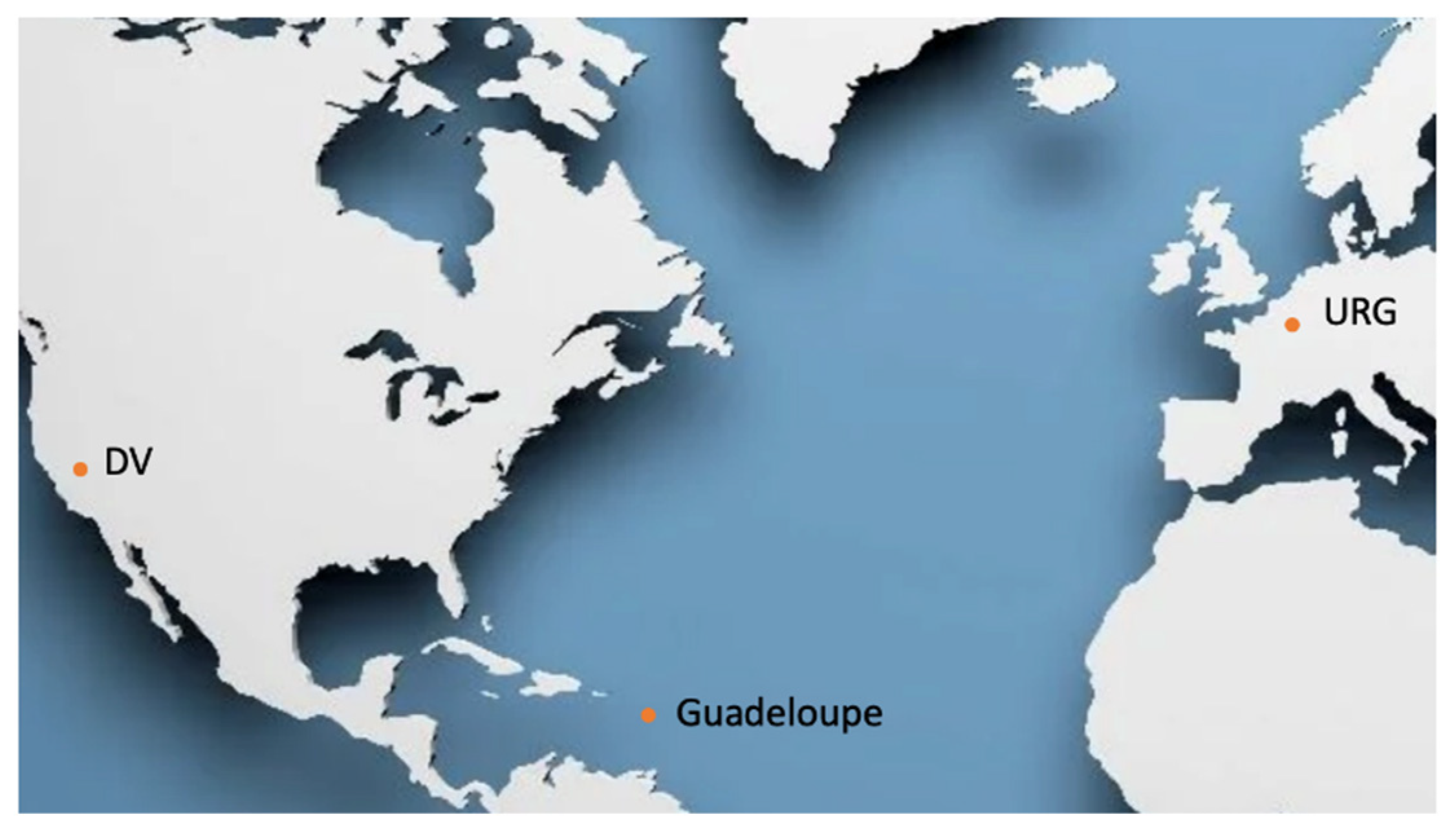
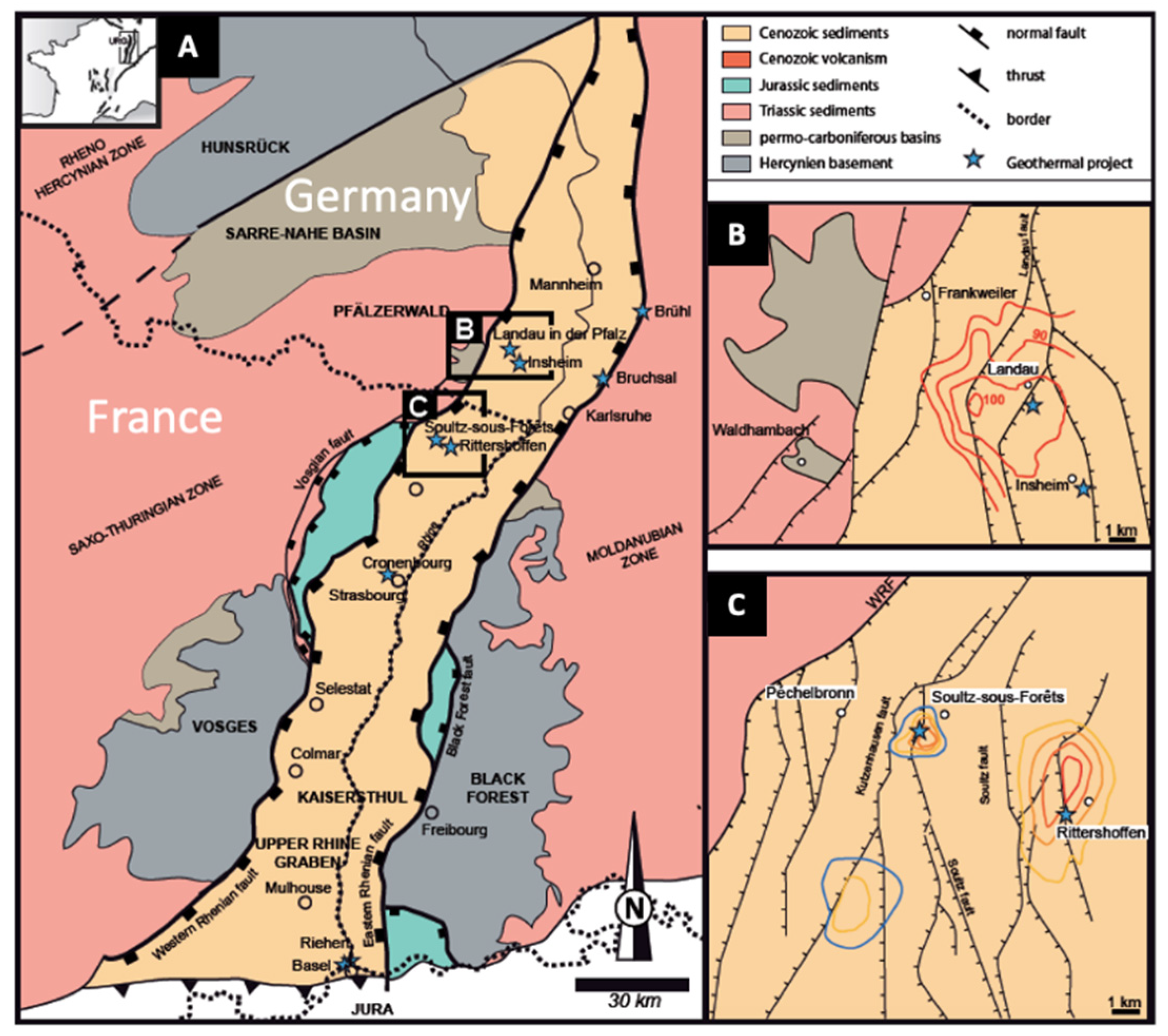
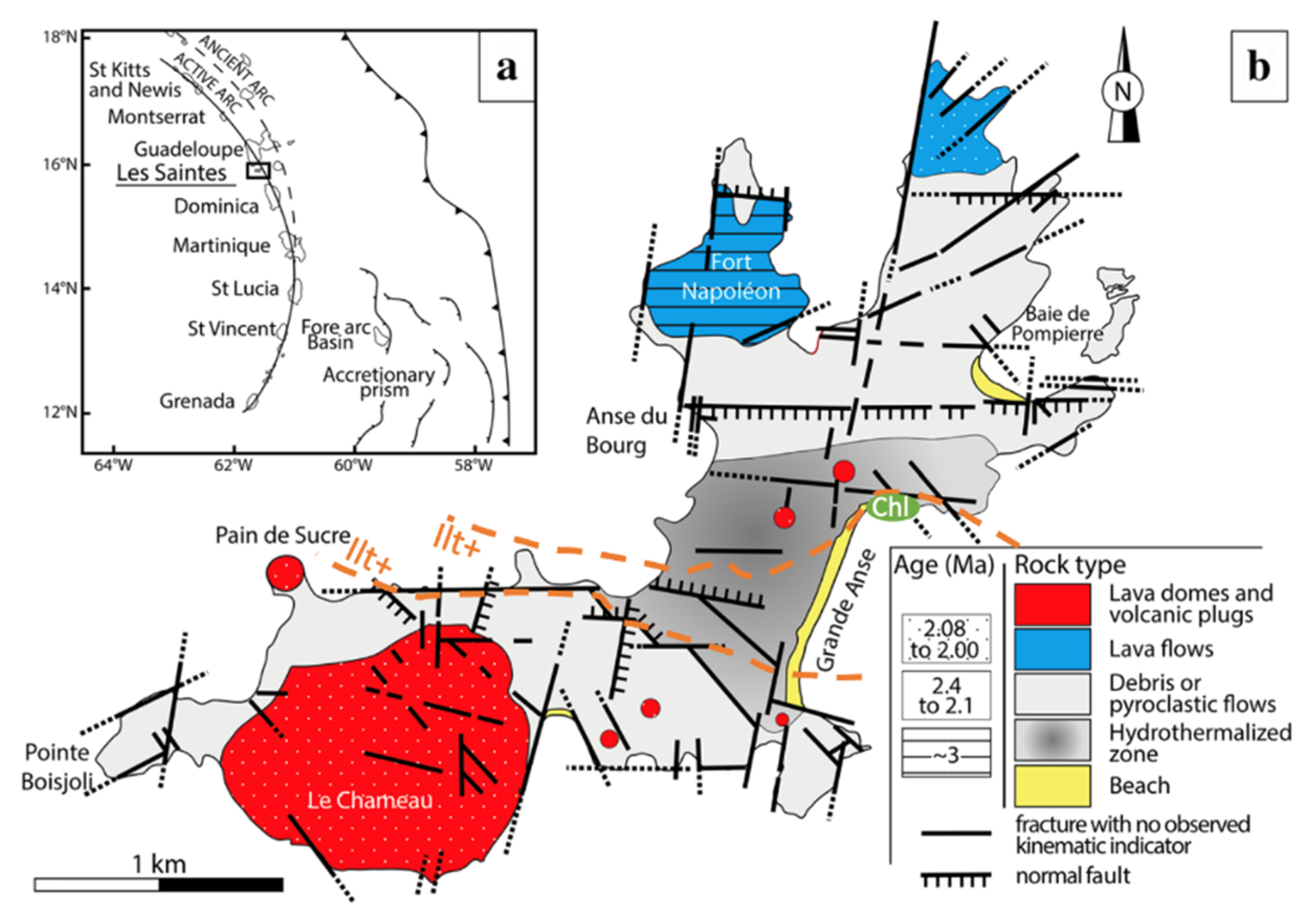
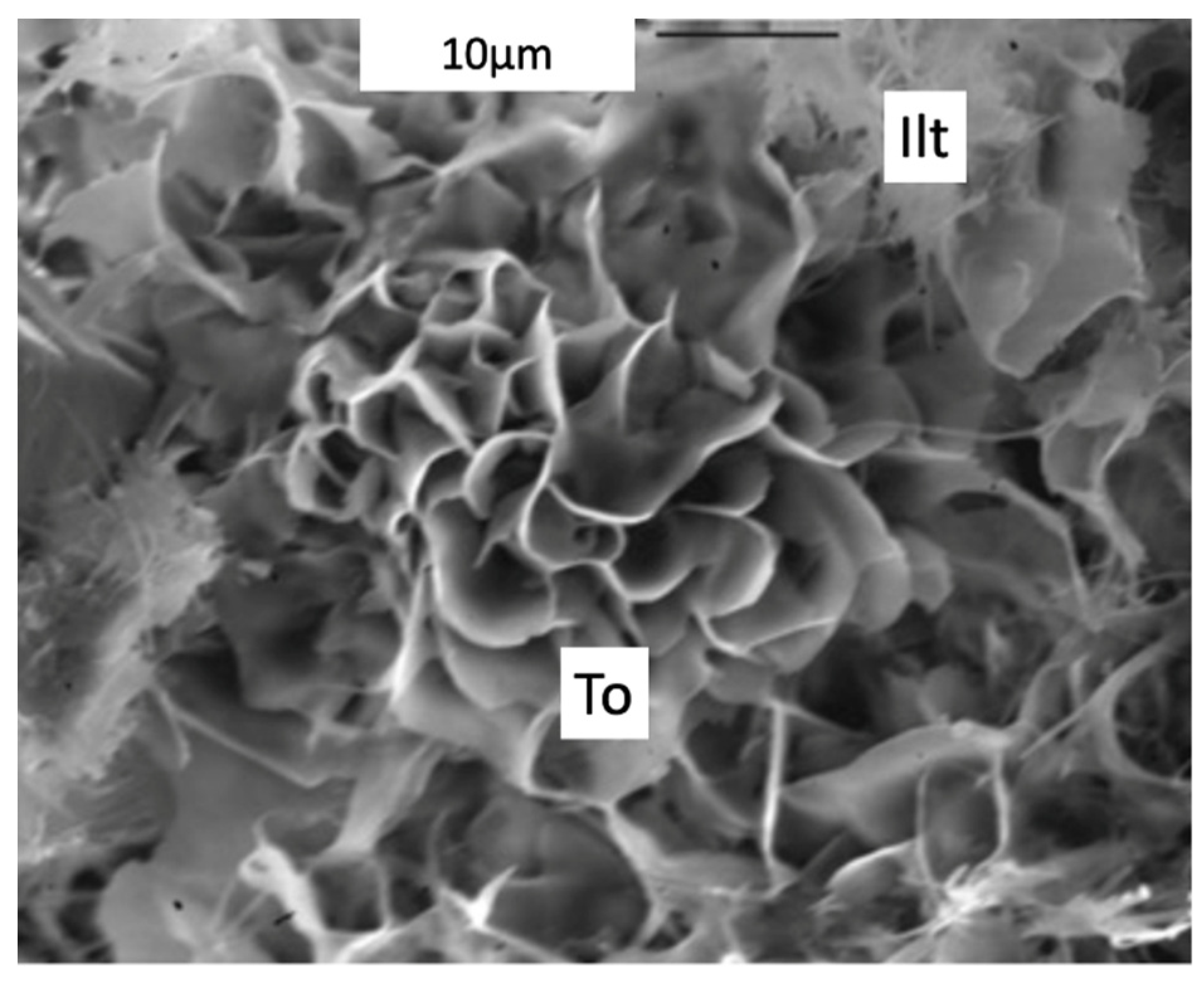
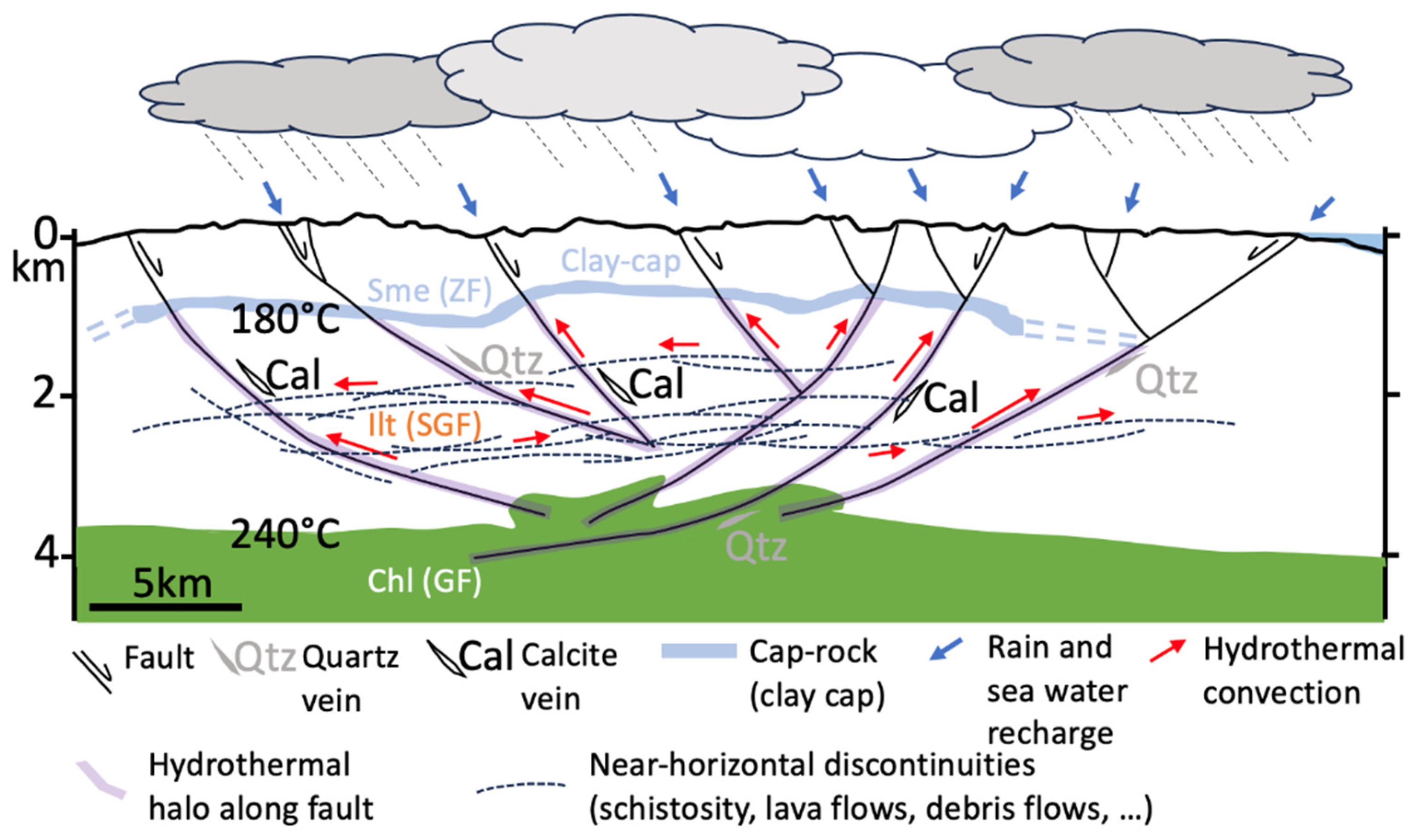
Disclaimer/Publisher’s Note: The statements, opinions and data contained in all publications are solely those of the individual author(s) and contributor(s) and not of MDPI and/or the editor(s). MDPI and/or the editor(s) disclaim responsibility for any injury to people or property resulting from any ideas, methods, instructions or products referred to in the content. |
© 2023 by the authors. Licensee MDPI, Basel, Switzerland. This article is an open access article distributed under the terms and conditions of the Creative Commons Attribution (CC BY) license (http://creativecommons.org/licenses/by/4.0/).



